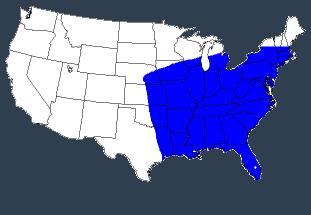

Descriptive Qualities:
Range
The Royal Walnut's range is
Map of this moth's Area:

Eggs and Larva
Unknown by me, will post when available.
Scenting and Mating
Female Royal Walnut moths usually put their scent out from . The males may come in at any time during this period. It is easiest to put the female in a metal cage with holes big enough that they can mate through it (about a half inch or 3/4 inch hole should do nicely) but small enough that the female cannot escape. This way is the only real way to tell how many came in.
Cocoons
Personal Markings or Characteristics
Caring For Royal Walnut moths, In All Stages:
Here are some notes that may be helpful when trying to raise Royal Walnut larva, especially if it's your first time raising them.Caring for the eggs
To care for Royal Walnut moth eggs, just put them in a small container. It is best to be small, because the larva like to crawl a lot when they first hatch, and if you put them in a bigger container, they will crawl away from the food you put in with them, and might not be able to get back. That's a lot of area for such a small caterpillar.
Food Plants
Raising Royal Walnut Larva (Inside)
Unknown, will post when available.
Raising Royal Walnut Larva (Outside)
Unknown, will post when available.
Caring for the cocoons
Caring for the cocoons is pretty simple. You should put them in an area where it is fairly moist, if the cocoons dry out, they will die. If you just put them outside they should be fine. You cannot leave them inside, because they will hatch, but you can keep them in the refridgerator. If you do this, it is best to spray the cocoons with a light mist every once in a while so they don't dry out.
Click here to return to the Index
Comments and suggestions are welcome, send them to me at: [email protected]